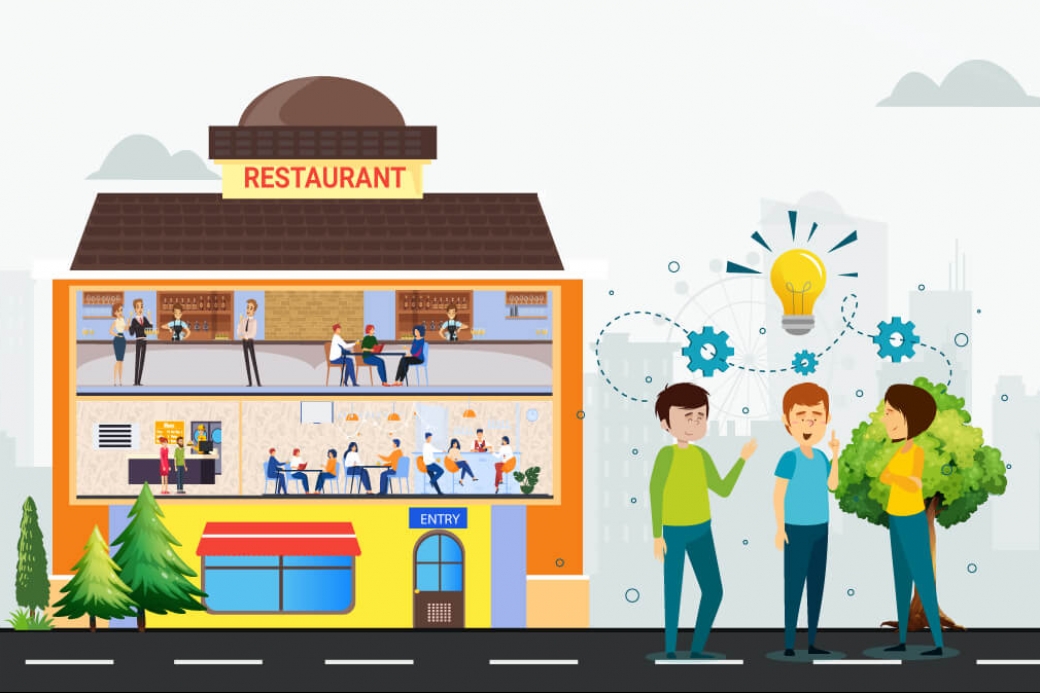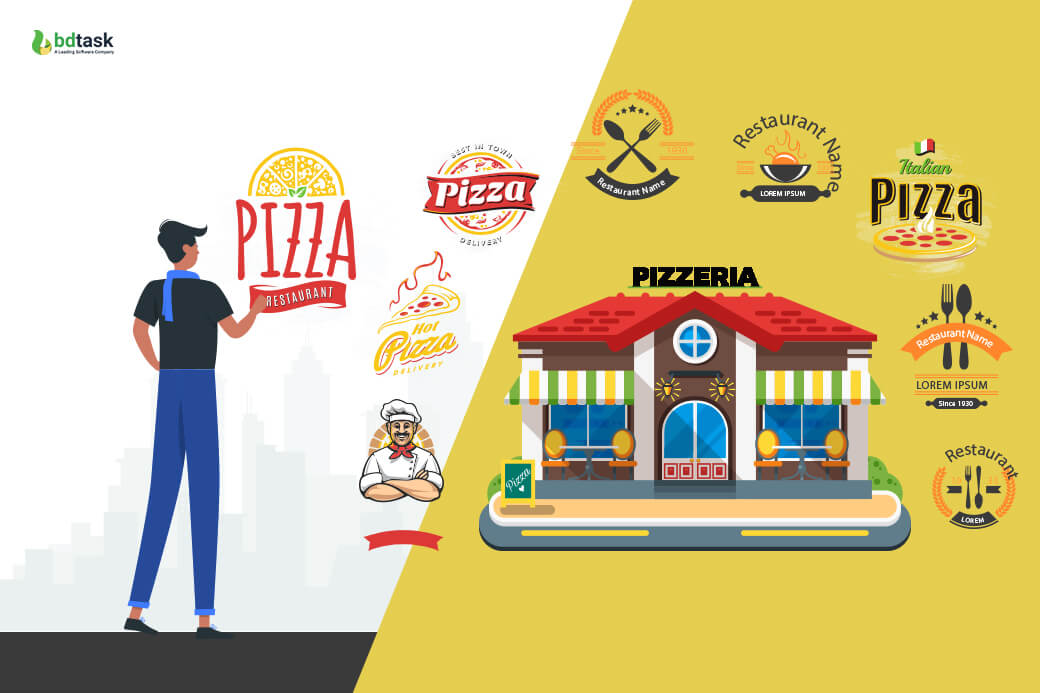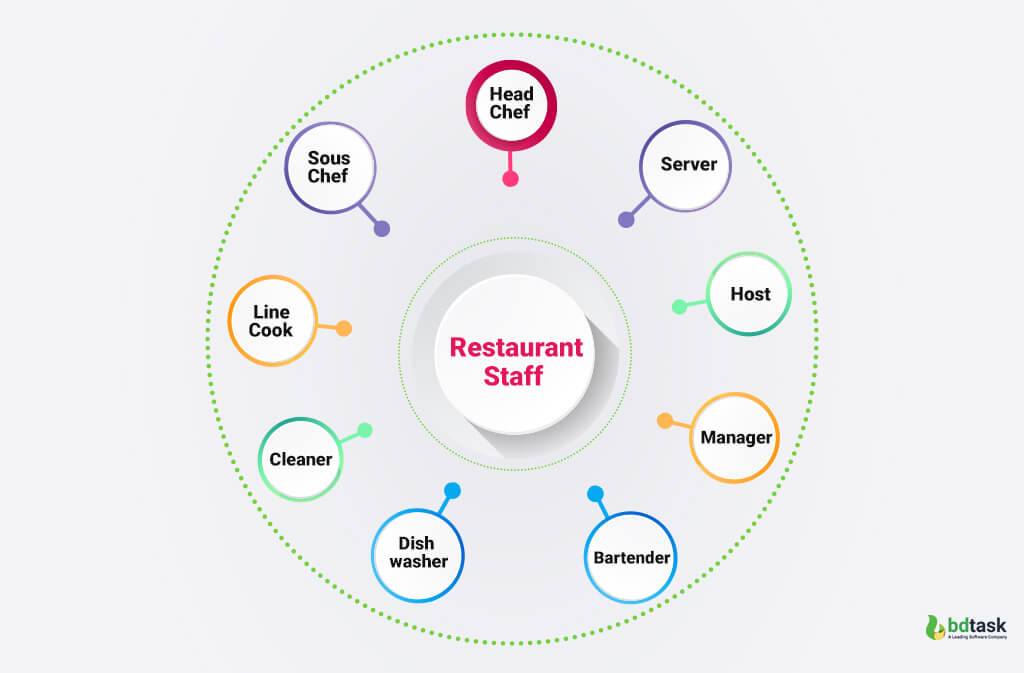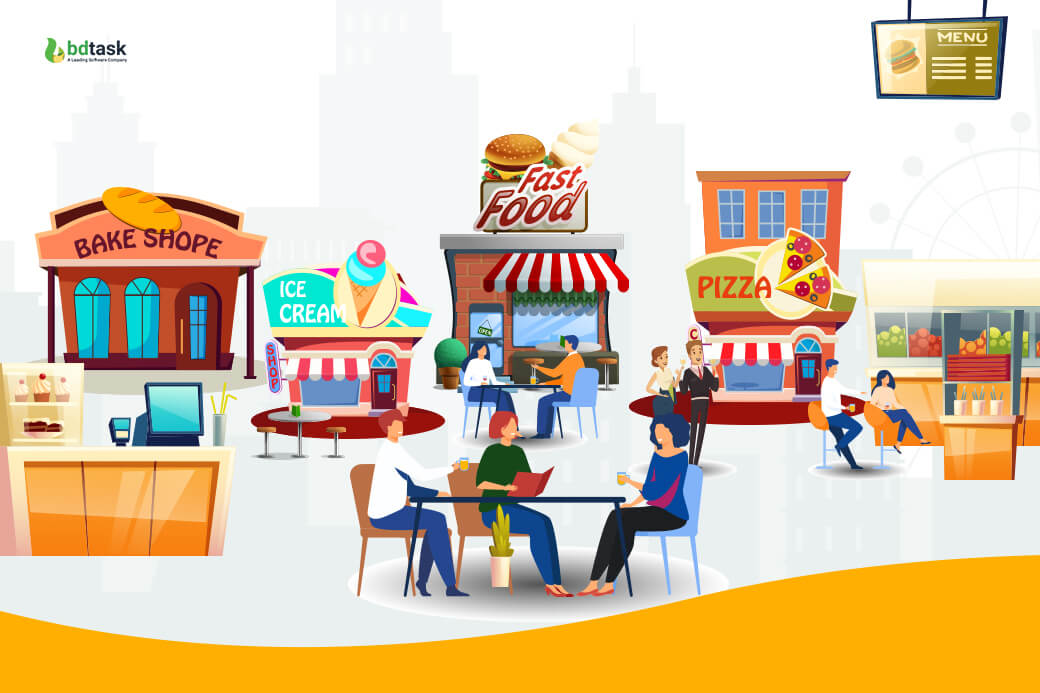How to Start a Restaurant: From Concept to Grand Opening

The restaurant business is now the leading business in the world. Extreme demand and high profit attract more and more entrepreneurs into the restaurant business.
However, many restaurants fail due to a lack of adequate knowledge. So, if you are eager and willing to enter the restaurant business, you must know how to start a restaurant business.
Structuring a restaurant business plan is like shaping your future goal. Remember, a well-defined restaurant business plan will always give you clarity on all the aspects of your restaurant business, including the marketing plan for your product, financial matters, operation, and product details.
“vision without execution is daydreaming”
Bill Gates
A business plan not only helps to execute every mission but also helps to give a better understanding of reality. So, walk with us and get ideas on how to develop a restaurant and make more revenue.
How to Start a Restaurant: 14 Essential Steps for Success
The restaurant business is highly competitive. So, while you are on the way to opening a restaurant, you should be very careful in every step. One wrong movement can be a threat to your restaurant. You must be clear about the things you need to run a restaurant. Here, we will discuss the 10 essential steps to opening a restaurant.
1. A Well Define Restaurant Plan
It doesn't matter whether the restaurant is large, medium, small, or just a tiny cart restaurant; a well-defined restaurant business plan is mandatory. A strong restaurant business plan also helps attract strong investors or banks or make silent partners.
A restaurant business plan holds all the detailed answers on how to start a restaurant or restaurant monthly expenses. It considers all the precious details on how you plan to turn all your investments into profit and how much you can stand your restaurant in the saturated market.
A business plan should contain the whole abstract idea involved within the restaurant. Such as:
-
Business Description
In your business plan, you should write a detailed business description. This description should include your visions and missions, types of restaurants, selling proposition, business growth, and many other aspects related to the restaurant business.
-
Menu and Offerings
As we know, menus play an important role in restaurants. So, you must include your menus and offerings in your business plan.
-
Operation Plan
Restaurant operation is one of the most challenging tasks in the restaurant business. The food and beverage business plan must include a fully organized restaurant operational strategy, which includes opening hours, closing hours, staff roles, working flow, and other tasks. However, an effective operational plan can reduce food waste in restaurants.
-
Marketing and Sales Strategy
Your restaurant business plan definitely includes a restaurant's marketing budget and sales strategy. This strategy includes branding, advertising, loyalty programs, etc.
-
Legal and Licensing
Your restaurant business requires different types of legal and licensing issues. So, you must include all the requirements in the business plan. Some essential legal and licensing issues are food safety, health safety, business regulations, liquor licenses, zoning permits, etc.
Additional Note: Making a business plan may take a lot of time and stress, but the reward you will get will be worth it.
2. Set the Right Restaurant Name

Deciding the right restaurant name is like naming your newborn baby.
"The first impression is important, but the last impression we leave with the customer will leave the most lasting impression" - Shep Hyken
Remember: The restaurant's name is the first thing people may know, see, confront, and hear. In any case, it fails to impress people's minds; therefore, people might reject the restaurant more efficiently.
Deciding a restaurant's name is tricky; there are seven or more essential steps to remember when determining a perfect restaurant name.
Here are some primary points that help to construct the name for your restaurant:
- The restaurant name should be easy to pronounce.
- The restaurant's name should be fresh and unique.
- Restaurant names should be both understandable and reachable.
- Restaurant name shall not match with the competitor.
3. Choose the Suitable Location for Your Restaurant
Choosing the right location is an essential and challenging decision when entering the restaurant business. You should select a spot that is easily accessible and draws the attention of your targeted audience. So, choose a location visible to passersby, such as people on foot or in cars. On the other hand, you have to make sure the location comes within your budget.
Why do you need the business plan to select the correct location for your restaurant? The appropriate answer to your question is that the restaurant business plan contains all the research points of all the sites considered a perfect spot for your restaurant.
A restaurant business plan contains:
- Which location is most famous for the restaurant / cafe / juice or mocktail bar / small snack parlor?
- Where do people most visit for their meal?
- Per square feet rent?
- Which is the most crowded place?
- Which location has no or decent quality full restaurant, and people of that location crave a place to eat?
Let's Discuss the two different case studies:
Case Study 1:
Imagine you are new to the restaurant business with no backup experience. You have selected a narrow, empty, dark path for your restaurant, where people rarely visit.
Just because the rent is low, but there is no crowd, and the number of people crossing from that street is low, it won’t help your restaurant grow. Hence, soon, you may get kicked out of this restaurant business.
Case Study 2:
As a start-up restaurant owner, it is better to lease a space for your restaurant. Leasing space for your restaurant not only opens up an opportunity to research, discover, and explore the specific location you choose. But also it has the flexibility of shift in case you didn't like or didn't get enough productivity.
Tips: Even if you plan to open a small cafe or start a low-budget restaurant, make sure you have selected a suitable location. Entering a restaurant business may not only be a business for you but also an investment in your daily bread and butter.
4. Decide Your Mission of Starting a Restaurant
The restaurant's mission statement is the most crucial part that many investors will read or identify. Because in this part, the whole restaurant business activities will break down. This mission statement summarizes, "Why did you plan to start a restaurant?"
Here are some additional terms that should be included in the mission statement.
- How will you manage to run your business on your own
- What kind of services you’re going to offer
- The number of staffs you are going to hire
- What kind of foods you’re going to serve
- Find a punctual supplier team
- A concise description of their management system and operation
5. Analysis of Target Customer
The first step in starting any business is deciding who your target audience is. The better you understand your customers, the more you will be able to satisfy them by fulfilling their needs. Identifying your target market is also a big part of your restaurant business.
The only tool through which you can identify your target customers is research. You must mention all the research output in your business plan.
- What demographic group are you going to target? The age range.
- What gender are you going to consider?
- Their income level?
- Target customers' purchase habits?
- What techniques should be used to cope with the new generation?
Tips: You can only apply all those target customer tools when you finalize your menu, interior, price of foods, and restaurant names.
For example:
Suppose you design a restaurant named "Men in the House". The interior refers to the age range of 40 to 50 people. Since you designed this restaurant to serve 40+ people, the food should be healthy and have fewer calories.
But according to the menu, if you offer cheesy steak and mashed potato, etc, which contain an outrageous amount of calories. Therefore, the problem with this restaurant is that the name is quite confusing. The word "men" raises a lot of confusion, such as when referring to the young, middle-aged, or old-aged.
Remember: Never confuse a customer; otherwise, you may lose the customer.
6. Find Your Competitor
Finding your competitor is an important term for the queries of how to open a restaurant. So, always keep an eye on your competitors: Research your traditional and digital competitors. First, find out who your competitors are. Please make a list of them and then do some analysis.
Only by understanding your competitors better can you easily measure and have an unobstructed view of your business’s weaknesses. As a result, you can defend or develop an alternative solution, which may help you perform better.
Hence, it can generate more effective value propositions and create unique marketing strategies.
Let’s discuss the different types of competitors.
-
Direct Competitors
Direct competitors whose restaurants are similar to yours and the interior and cuisine target the same segmented customer. Therefore, it will be wise for you to study or monitor your direct competitors intensely.
By analyzing those direct competitors, you can know and understand their mistakes and develop a unique solution and unique technology and facilities.
-
Indirect Competitors
In the indirect competitors whose restaurant won’t match your theme and cuisine, as well as your targeted customer. By observing the indirect competitor, you can adopt some of their techniques, such as “how they approach their customers?” “What is their menu?” “Which strategy do they follow to create their uniqueness?” etc.
-
Digital Competitor
A restaurant should also consider that the modern generation usually searches Google Maps for the nearest restaurant or cafe. Therefore, making your restaurant trackable on the Google map is also essential.
-
Local Competitor
A local competitor is always your first competitor since you and other restaurants will be doing business in the same location. Your target customer is already the competitor's loyal customer, so plan your restaurant business wisely.
7. Get the Necessary Funding
The most important part of starting a restaurant is getting the necessary funding. Millions of people ask how to start a restaurant with no money. In general, it is impossible to build a restaurant without money.
But it is possible to start a restaurant without investing your own money. In that case, you can get funding for your restaurant. There are many different ways you can fund your restaurant.
Here, we will discuss all the funding criteria for starting a restaurant.
-
Your Own Investment
Investing your own money is the first option for building a restaurant. In that case, the restaurant owner uses their money to start a business. This type of investment is the safest investment.
-
Commercial Loan
Commercial loans play an important role in restaurant funding. It is a type of loan that the bank directly provides with lower interest. So, you can apply for a commercial loan in a bank to open a restaurant.
-
Small Business Administration Loan
SBA is perfect for you if you want to get involved in a small restaurant business. SBA helps those willing to start small businesses; SBA provides funds for them. One major benefit of having an SBA loan is a low interest rate.
-
Business or Credit Card Loan
The restaurant business entrepreneur can apply for credit card loans by using their credit card. In that case, they are limited to a bounded amount of funding. Moreover, they have to pay a certain monthly fee for their credit card loan.
-
Personal Investor
Finding an independent investor is another way to finance your restaurant. In that case, you may seek help from any person or company. But most of the time, you may have to share some percentage of your business profits while selecting a personal investor.
8. Create a Unique Menu
A menu is the heart of any restaurant. It is the only thing that attracts and retains customers. The taste of the food will reflect all the other aspects of your restaurant.
Before setting the menu, you must analyze the target customer, the latest food trends, and the hot-selling dishes, snacks, and drinks. So, you must create a unique menu card for your restaurant.
Remember, you should make your menu simple and not contain any hidden costs. A good menu can make your restaurant more famous.
Tips: You can show off the description of the dish and the item you’ll use to prepare the food. You can also provide a realistic image of the food to attract the customer. Providing a realistic image might also open an opportunity for impulse buying.
9. Get the Space and Make Layout
Now, it is time to find a commercial space for your restaurant. However, you must keep an eye on the location while finding space. Market analysis may help to find a suitable commercial space.
Another important thing to do when choosing a space is to ensure it is easily visible to the customers. Then, you have to do the process of getting the space for the restaurant. Remember, a good interior design plays a crucial role in restaurant business.
In that case, you can buy or rent the space. It depends on you and your budget. After getting the space, you have to make a layout for your restaurant. Your restaurant opening layout includes different terms.
For example:
- Restaurant Seating Space
- Cooking Area
- Washing Space
- Food Preparation Area
- Dry and Cold Storage
- Staffs Room
- Waiting Area
- Refreshment Space and Others.
10. Fulfill License and Permit Obligations

You have to undergo severe legal procedures for starting a restaurant. Before opening a restaurant, you must obtain permission from both state and local permits.
The legal procedure for starting any business is to collect a trade license, alcohol license, Tin, and Bin certificate. Additionally, you need to get a food hygiene certificate and food premises acceptance to prove that you will serve fresh food.
Last, you must obtain a clear chit certificate from the food inspector.
11. Get All the Equipments
Collecting the correct equipment is very important. This includes both back of the house and front of the house equipment. Proper front-of-the-house equipment has a positive impact on the restaurant's decoration.
Additionally, adequate kitchen equipment makes cooking a dish or meal much more delicious. However, this equipment is costly, so buying the right one is better. Please write down all the necessary equipment depending on the menu you cook.
After you list all the equipment you'll need, set your budget and financial plan and show it in the business plan. The business plan should include all the cash inflow and outflow spent on equipment.
12. Hire the Staffs

Running a restaurant without human resources or with unqualified staff is challenging. So, you must hire qualified staff, which will help you manage the whole operation of your restaurant.
Before you go through the recruitment process, list how many staff you need to run both front and back of your restaurant. Managing the entire team can be challenging.
In that case, you can use some brilliant advanced technology such as the Bhojon-Restaurant Management System. This software can conveniently manage the whole team, such as supervisor, food and beverage purchasing, inventory management, cooking helping hand, cleaner, marketing team, accountant, etc.
Ensure the staff you choose have general knowledge of their appointed position. Besides, all must be able to perform multiple tasks and have the potential to work calmly under pressure.
However, you may also make some arrangements to train your restaurant staff.
Some fundamental position that is needed when opening a restaurant such as:
- Head Chef
- Sous Chef
- Line Cook
- Maintenance and Cleaning Staff
- Dishwasher
- Server
- Hosts
- Manager
- Bartenders
13. Marketing Plan and Promotional Ideas
Marketing is like advertising all your products or services to your customers. So, the entire marketing plan for your restaurant business should be more potent than anything else.
Restaurant marketing plans explain “how you’re going to reach your targeted customers' minds.” Don't worry if you’re starting as a small, medium, or large restaurant; you need to do some marketing; otherwise, you may fail to reach your product to your customers. So, if you look for how do i start a restaurant business, these marketing and promotional strategies can be helpful.
Here are some unique marketing strategies for your restaurant:
- Video marketing
- Email marketing
- Social media marketing
- Search engine optimization
- Promote your restaurant through a different food blogger
Special Note:
After implementing a great marketing plan for your restaurant, it is time to go for promotional ideas. At this period, you have to use an offer and promotional strategy to reach the customers.
Here are some important ideas:
- Exciting offers: buy1 get1, specific cardholder discount
- Happy hour meal
- Taste and review
14. Grand Opening
After completing all the arrangements, it is time for your restaurant to open. So, you must focus on a grand opening ceremony to get attention and make it memorable. It can be a good practice and can create a positive impact on your restaurant. You can apply different strategies while planning the grand opening.
Some important grand opening ideas are:
- On the opening day, you must focus on welcoming your guests.
- In some cases, you can offer your customers exclusive offers and discounts.
- You can invite social media influencers or food bloggers to advertise your restaurant.
- Regarding customer loyalty, you may give some exclusive gifts to your customers.
- Importantly, you may throw a memorable party with some entertainment to be memorable to the customer's mind.
What Type of Restaurant is Best to Start

While entering the restaurant industry, you might face a strange dilemma since there are different restaurant industry criteria. You may ask: what is the most popular type of restaurant, or which food business is most profitable? These are the important things to consider when opening a restaurant.
The better you specify your restaurant, the better you concentrate on your potential customers. So, the entrepreneur should research about the restaurant types while planning on how to establish a restaurant. Not only that, but determining which kind of restaurant you want to open will help you draw a better budget for your business plan.
There are different criteria for a restaurant:
-
Fast Food Restaurant
This restaurant usually serves food quickly. The seating arrangement is typically small or limited, making it a “take-away” restaurant. However, this restaurant provides a speedy payment service using the POS billing system.
-
Food Cart or Food Truck
This kind of small cart or truck-type restaurant usually has a small budget. It is a restaurant that doesn't have a fixed location. This kind of restaurant's owner roams around with their food truck or cart.
And wherever they get a crowd, such as outside the corner of any corporate office, school, or college, they start to do their business. This kind of food truck or cart usually serves overnight prepared ready-made or fast food.
-
Casual Dining
This kind of restaurant provides an entire sitting and relaxed ambience experience, and the food is always affordable. Casual dining is suitable for family outings and is also famous for its different food menus.
-
Family Restaurant
This restaurant provides a family atmosphere. It may have a separate kid zone or specialized baby chair so that the rest of the family members can enjoy their meal. This restaurant usually serves meals in the medium price range. It may also provide some special meals for children.
-
Candle Night Dining
Candle-night dining restaurants are usually for couples. The food is quite expensive, and the interior is very romantic and aesthetically ambient. People typically visit this kind of restaurant when they want to spend some exceptional quality time with their loved ones.
-
Juice Bar
A juice bar is usually not a restaurant; it typically serves juice. Additionally, this kind of bar ordinarily has very limited or no seats. It can serve a different kind of juice shake made from many other exotic fruits. The price range of this juice is fixed based on how rare the fruit is.
-
Coffee and Tea Bar
Coffee and tea bar restaurants serve different types of coffee and tea. It is usually medium-sized. As a side dish, this restaurant may also offer side snacks.
This restaurant’s main attraction is serving different tea and coffee criteria and types. You may get ideas on how to open a cafe with a low budget, and start your coffee and tea bar restaurants with limited money.
-
Meat and SeaFood Restaurant
This restaurant serves different types of meat and exotic seafood. All of these items are usually charged at a very high price since both meat and seafood are perishable. On the other hand, most seafood is only available in some specific seasons.
Both meat and seafood are midscale and upscale products in the market. The decor of this kind of restaurant applies a Western or cowboy theme with a comfortable seating arrangement.
-
Chinese Restaurant
We are all familiar with the fact that Chinese people consume raw foods, which is, on the other hand, challenging to adapt to in many countries. Therefore, even though you can start a Chinese restaurant, you may not sell authentic Chinese food.
Maintaining the originality of Chinese food may not match your country or state’s culture. Hence, mixing Chinese cuisine with the home country’s cuisine would be wise.
-
Burger and Pizza Restaurant
Burger and pizza restaurants usually provide a comfortable and colourful interior. Interior decor in such a way that even the walls also talk about burgers and pizza.
Apart from serving burgers and pizza, you can also serve sandwiches, different beverages or shakes, french fries, crispy cheese balls, etc. This pizza and burger restaurant usually charges very affordable and reasonable prices.
-
Chocolate and Jam Restaurant
If you choose to develop this kind of restaurant, I would like to inform you that chocolate is generally an expensive commodity. You can also serve a different type of exotic dessert made of chocolate, such as trending chocolate bomb ball, chocolate pie, chocolate truffle, chocolate lava cake, etc.
To increase the variety on your menu, add fruit jam items, such as apple jam, cranberry, strawberry jam, dragon fruit jam, jam, chocolate cookies, and pie.
This restaurant’s ambiance and interior always sets a classy, relaxing mood with a comfortable seating arrangement and esthetic design on the walls.
-
Biscuit, Cakes, Cookies and Bakery
If you are an expert in baking, you can easily open a cake and bakery restaurant. This kind of bakery restaurant doesn’t require much decoration; they mainly concentrate on keeping the food fresh and everything hygienic.
The price charge depends on how much it costs to produce the products. As extra accessories, you can keep balloons, sparkling candles, birthday candles, snow spray, etc.
Nowadays, most of the booming generation is doing this cake and bakery business online. “How to sell food online.”
-
Ice Cream Parlor
There can be two types of ice cream parlors. One is upscale, where you can offer many exotic homemade real fruit ice creams. These types of ice cream cost a very expensive price.
You can also serve different kinds of wafers to complement the ice cream. The interior of this upscale ice cream parlor offers a very posh, classy, and expensive seating arrangement.
On the other hand, it is a lower scale. It usually comes up either in a small shop or travellable cart. The price range of this kind of ice cream is very low since this kind of ice cream cart offers a very low flavor and company-made ice cream.
-
Buffet Restaurant
Nowadays, most restaurants follow a buffet-style lunch and dinner system. In this kind of restaurant system, all the items are there, open-endedly, and customers can eat as much as they want just by paying a fixed one-time payment.
Buffet-type restaurants usually charge very reasonable prices to the customers, and the ambiance is comfortable and cozy. They don’t serve any side dishes or snacks.
Now, the millions dollar question,
How Much Does it Cost to Start a Restaurant?
It is not so easy to answer this question. Starting a restaurant is a complex task. So, it is quite impossible to tell the exact amount of cost to open a restaurant. But we can provide some information that will help to estimate the restaurant startup cost.
The cost of opening a restaurant in the USA can range up-to $95,000 to more than 2.5 millions. Although, the cost can be changed anytime.
The restaurant startup cost varies on several factors, these are;
- Location of the Restaurant
- Restaurant Size and Types
- License and Permissions
- Employee Salary
- Equipment Cost
- Rent Cost and some other factors.
How to Manage Your Restaurant
Managing a restaurant is not easy. There are thousands of complex matters that need to be dealt with. To make the process more effortless, many restaurant owners hire external sources to handle the whole management system of a restaurant.
A restaurant business needs a lot of human help to serve the customer, for example, waiters, chefs, account heads (who control the POS machinery), cleaners, etc.
-
Human Resources
Adequate human resources can allow a restaurant owner to control the whole operation. Therefore, you must ensure an efficient human resource management and customer relationship management system to manage all human resources.
-
Technology supports “A Complete Guide of POS”
Apart from the human resources, a restaurant owner must have bought or rented a POS billing software. With the assistance of POS billing software, it controls almost everything in the operation of your restaurant.
Here are some facilities that you might enjoy by using the POS billing software:
- Centralize Data Saving Option
- Online Ordering Facilities
- Quick Payment Facilities
- Warehouse Management
- Table Reservation Management
- Can Be Operable Offline
-
Budget Analysis
Before opening or even planning to enter the restaurant business, the significant thing that comes and knocks your brain and mind to that, “Yes, I am ready to start my own restaurant business,” but wait:
- How do I generate that kind of money?
- How will I divide, plan, spend, and calculate financial statements if I get or arrange any capital source?
- What is an appropriate Initial investment?
- Forecasted profit and loss (at least 3 to 5 years of forecasted operation)
- Forecasted cash flow
- how to open a cafe with a low budget
- how much cost to open a small restaurant
- restaurant monthly expenses
- Break-even analysis
Final Thought
You might face difficulty structuring your dream project's pieces in the correct position. It might suck all your time and energy, make you stressed but trust me, it will be worth it. Planning a business plan helps you to stick with your dreams and goals. The above steps will assist you in developing a proper restaurant business plan and provide a guide to opening a restaurant.Therefore, it is smart to revisit and keep updating your plan as your business grows.
Special Note: This article also might be helpful for those, who are looking for an answer, how to open a small restaurant, how to start a small restaurant or how to open a restaurant with no experience.











